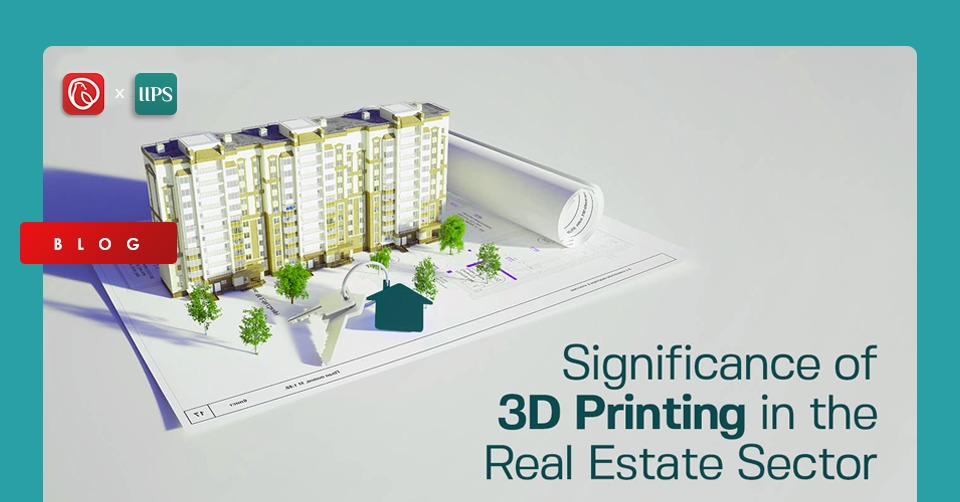
The real estate sector is rapidly adopting new technologies to meet the rising demands and challenges of the 21st century. Issues related to affordable housing, sustainability, and productivity have prompted companies to bring innovation in construction technologies, building management systems, and development planning tools. 3D printing is now past the stage where it was considered just a gimmick technology. Many industries in the manufacturing, healthcare, and real estate realm are adopting it for various purposes. 3D printing provides massive benefits such as affordability, offsite construction, faster processing, better quality, and significantly lesser time in the real estate sector. Additive manufacturing, or 3D printing, is bringing much-needed ingenuity and convenience to a whole new level. Continue reading the article by the Iqbal Institute of Policy Studies (IIPS) to understand the concept of 3D printing and its relationship with the real estate sector.’
3D printing is an exciting technology that will see its application in many industries in the future. The process involves making three-dimensional solid objects from a digital model file. It is also known as the additive process because an object is created by placing thin layers of materials on top of each other in repetition until it is completed (Cummins, 2010). Considering that machines can print in exact shapes and designs, less material is used than subtractive manufacturing. A product is obtained by removing material from more giant blocks of raw substance. The process starts by making a 3D model of the final product. Accurate details can be set for each dimension, and extreme preciseness can be achieved. The model is then sliced using software into hundreds of thousands of layers so that the printer can print each layer on top of another. Many materials can then be used to 3D print, including plastics, resins, metals, carbon fibre, graphite, nitinol, and paper (SDC, 2021).
Considering the flexibility 3D printing allows for manufacturers, the technology is fast becoming a standard in industries requiring precision making and robust structures. Traditional construction methods have design restrictions. But with 3D printing, a large amount of flexibility can be practised. Similarly, prototyping is another area that becomes faster and easier with 3D printing. Testing out multiple designs in varying sizes can open various opportunities for research and planning. Another factor worth considering is that 3D printing can be done on-demand as not a lot of space is required to store inventory. 3D Printing also minimises waste as large chunks of non-recyclable material are not required to be cut off and disposed of. Instead, raw materials are used according to their exact estimations. Therefore, keeping in mind the multiple benefits of 3D printing, continue reading to understand the significance of 3D printing in the real estate sector (TWI, 2021).
Real estate has seen the highest number of disruptions in the face of new and innovative technological inventions. 3D printing has proven its worth in the real estate sector in several ways, making the technology a lucrative prospect for the future of real estate development. While 3D printers remain expensive on their own, savings in logistics, labour, and material can offset the total overall expense once purchased. Many developed and developing countries are trying hard to figure out solutions for their affordable housing problem. Using 3D printing technology, it is now possible to build economical homes for financially challenged people. For instance, the Winsun building in Shanghai, China, is a five-story 3D printed building completed at the rate of one story per day at a total cost of only 160,000 US Dollars.
There are also many places where construction has remained impossible only because it is difficult to reach them with cranes and other construction equipment. By using 3D printing technology, building elements can be constructed off-site and placed anywhere. In many parts of the world, buildings are now being built offsite and later transported to the actual site location. The World’s Advanced Saving Project (WASP) has recently started testing additive manufacturing (3D printing) in remote areas to create small rural villages (Mobifilia, 2021). The homes are built using entirely local resources. If 3D printing becomes more common, it can also give people the freedom to design their own living spaces. Lastly, 3D printing can also significantly reduce carbon emission in the real estate sector, as it is one of the highest producers of greenhouse gases. Therefore, 3D printing technology will undoubtedly revolutionise the real estate sector in the years to come.
It can be seen that 3D printing has a bright future in real estate. Many real estate developers are slowly adopting the technology using different materials and techniques. The benefits of time-saving, cost efficiency and reduced costs far outweigh the perceived expenses in setting up 3D printing plants. Also, with the ability to carry out offsite construction, 3D printing can provide the impetus for the growth of modular construction. All in all, the introduction of new technologies is the way forward for the real estate sector.
Dubai’s residential real estate market maintained its upward momentum in November 2025, with the latest…
Saudi Arabia’s Real Estate General Authority (REGA) has announced the launch of a new platform…
Dubai: Tomorrow World Group, a global enterprise with a 20-year presence in the emirate, has…
Islamabad: The Capital Development Authority has begun a citywide rehabilitation and upgrading campaign, starting…
Dubai: The emirate’s real estate sector continued its strong performance in November 2025, posting transactions…
The 19th Real Estate Development Summit Saudi Arabia Luxury Edition ended after two days of…